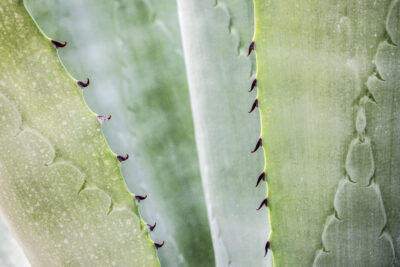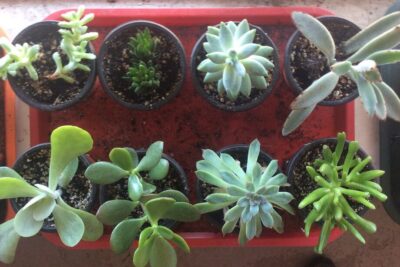
Can Succulents Survive a Freeze Unprotected?

Succulents are a popular choice among plant enthusiasts due to their unique and eye-catching appearance. These plants have thick, fleshy leaves and stems that allow them to store water and survive in arid conditions. However, one question that often arises is whether succulents can survive a freeze when left unprotected.
We will delve into the topic of how succulents fare in freezing temperatures without any form of protection. We will explore the natural adaptations of succulents that help them withstand cold weather, as well as the factors that can make them more vulnerable to frost damage. Additionally, we will discuss some practical tips and measures you can take to help your succulents survive a freeze and thrive in colder climates.
- Yes, succulents can survive a freeze unprotected
- They have adapted to withstand harsh conditions
- Some succulents are more cold-hardy than others
- Succulents can tolerate short periods of freezing temperatures
- However, prolonged exposure to freezing temperatures can damage or kill them
- It is best to protect them during extreme cold weather
- Covering them with a frost cloth or moving them indoors can help keep them safe
- Providing them with extra insulation, such as mulch, can also help protect them
- Watering them sparingly during winter can prevent the soil from freezing and damaging the roots
- Proper care and attention during freezing temperatures will increase their chances of survival
- Frequently Asked Questions
Yes, succulents can survive a freeze unprotected
Succulents are known for their ability to withstand harsh conditions, including freezing temperatures. While some succulents may not be as frost-resistant as others, many varieties are surprisingly hardy and can survive a freeze without any special protection.
Here are a few reasons why succulents can thrive in freezing conditions:
1. Adaptation to dry climates
Succulents are native to arid regions where they have adapted to survive in extreme temperatures. Their thick, fleshy leaves and stems act as water reservoirs, allowing them to store moisture during periods of drought. This unique adaptation helps them withstand freezing temperatures by preventing ice crystals from forming inside their tissues.
2. Tolerance for temperature fluctuations
Succulents have the remarkable ability to tolerate a wide range of temperatures. They can withstand both scorching heat during the day and freezing cold at night. This natural resilience makes them well-suited for surviving sudden drops in temperature without suffering significant damage.
3. Dormancy during winter
Many succulents enter a period of dormancy during the winter months. This means that their growth slows down or stops altogether, allowing them to conserve energy and protect their vulnerable parts from freezing temperatures. While in dormancy, succulents may appear less vibrant or show signs of wilting, but they will bounce back once the temperatures rise.
 Protecting Succulents: Tips for Cold Weather Survival
Protecting Succulents: Tips for Cold Weather Survival4. Natural insulation
The unique structure of succulents provides natural insulation against the cold. Their thick leaves and stems act as a barrier, protecting the inner tissues from frost damage. Additionally, some succulents have a waxy or hairy coating on their leaves, which helps reduce water loss and insulates them from extreme temperatures.
While succulents are generally resilient to freezing temperatures, it's important to note that prolonged exposure to extreme cold can still cause damage or even kill them. If you live in an area with severe winters, it's advisable to provide some protection for your succulents during freezing spells. Here are a few tips:
- Cover your succulents with frost blankets, burlap, or old bedsheets to provide an extra layer of insulation.
- Move potted succulents indoors or to a sheltered area, such as a garage or porch, during freezing weather.
- Water your succulents sparingly during winter to prevent excess moisture, which can lead to rotting.
- Avoid fertilizing your succulents during the dormant period, as this can stimulate new growth that may be more susceptible to cold damage.
By understanding the natural resilience of succulents and taking some precautions during freezing temperatures, you can enjoy these beautiful plants year-round, even in colder climates.
They have adapted to withstand harsh conditions
Succulents are known for their ability to survive in extreme environments, from scorching deserts to freezing temperatures. These resilient plants have developed unique adaptations that allow them to thrive in harsh conditions.
What are succulents?
Succulents are a type of plant that stores water in their leaves, stems, or roots. This adaptation helps them survive in arid environments where water is scarce. They have thick, fleshy leaves or stems that can store large amounts of water, allowing them to withstand prolonged periods of drought.
Can succulents survive a freeze unprotected?
While succulents are well-equipped to handle drought and heat, they can also tolerate cold temperatures to some extent. However, their ability to survive a freeze largely depends on the species, the duration of the freeze, and the conditions they are exposed to.
Generally, most succulents can tolerate brief periods of freezing temperatures, especially if the plant is healthy and well-established. However, prolonged exposure to freezing temperatures can be detrimental to succulents, especially those that are not cold-hardy.
 Using Regular Miracle Gro Fertilizer: Is it Suitable for Succulents?
Using Regular Miracle Gro Fertilizer: Is it Suitable for Succulents?Cold-hardy succulents
Some succulent species are naturally more cold-tolerant than others. These cold-hardy succulents have evolved in regions with freezing temperatures and have developed additional adaptations to protect themselves from frost damage.
Examples of cold-hardy succulents include various species of Sedum, Sempervivum, and Agave. These plants are capable of surviving freezing temperatures and can even withstand snow and ice. They are often grown in regions with colder climates and are a great choice for outdoor gardens in areas prone to frost.
Protecting succulents from freezing temperatures
If you live in an area where freezing temperatures are common, it's important to take precautions to protect your succulents during the winter months.
- Provide shelter: Move potted succulents indoors or into a greenhouse during freezing weather to shield them from extreme cold.
- Use frost cloth or blankets: Cover outdoor succulents with frost cloth or blankets to provide an extra layer of insulation and protect them from frost damage.
- Avoid overwatering: During winter, succulents enter a period of dormancy, and their water requirements decrease. Overwatering during cold weather can lead to root rot and other issues.
- Choose cold-hardy species: If you live in a frost-prone area, consider selecting cold-hardy succulent species that are better adapted to withstand freezing temperatures.
By following these tips, you can help your succulents survive and thrive even in freezing temperatures.
In conclusion,
succulents have evolved to withstand a range of harsh conditions, including freezing temperatures. While some species are more cold-tolerant than others, it's important to provide proper care and protection during winter to ensure their survival. With the right precautions, you can enjoy the beauty of succulents in your garden year-round.
Some succulents are more cold-hardy than others
When it comes to surviving a freeze, not all succulents are created equal. Some varieties have a natural ability to withstand colder temperatures, while others are more sensitive and require extra protection to prevent damage.
 Succulent Care on Wood: A Guide to Proper Maintenance
Succulent Care on Wood: A Guide to Proper MaintenanceIf you live in an area with freezing winter temperatures, it's crucial to choose cold-hardy succulents for your garden. These resilient plants can tolerate frost and even thrive in colder climates. Examples of cold-hardy succulents include Sedum spectabile, Sempervivum tectorum, and Agave parryi.
On the other hand, tender succulents such as Echeveria and Aloe vera are less cold-tolerant and may suffer damage or die if exposed to freezing temperatures for an extended period. It's essential to know the specific cold-hardiness rating of each succulent species you have to determine the level of protection they require.
Protecting your succulents during a freeze
If you have less cold-hardy succulents in your garden or want to protect your plants during an unexpected freeze, there are several measures you can take:
- Bring them indoors: The easiest way to protect tender succulents is to bring them indoors during freezing temperatures. Place them near a sunny window or under grow lights to ensure they receive enough light.
- Cover them: If bringing your succulents indoors is not an option, covering them with blankets, burlap, or frost cloth can provide temporary protection. Make sure the covering reaches the ground to trap the heat generated by the soil.
- Use heat sources: Placing heat sources, such as heat lamps or outdoor heaters, near your succulents can create a warmer microclimate and prevent freezing. Be cautious not to place the heat source too close to the plants, as it can cause damage.
- Water them: Watering your succulents before a freeze can help insulate them and provide some protection against the cold. Moist soil retains heat better than dry soil, so make sure to water a few days before the expected freeze.
- Move them to a sheltered area: If your succulents are in pots, you can move them to a sheltered area, such as a garage or covered patio, during freezing temperatures. This can offer some protection from the cold winds and frost.
Remember, prevention is key! Choosing cold-hardy succulents for your garden and providing adequate protection during freezing temperatures will increase the chances of your plants surviving unscathed. By taking these precautions, you can enjoy the beauty of succulents year-round, even in colder climates.
Succulents can tolerate short periods of freezing temperatures
One of the most common questions among succulent enthusiasts is whether or not these plants can survive a freeze without any protection. While succulents are known for their ability to thrive in arid and dry conditions, they do have some limitations when it comes to extreme cold temperatures.
Succulents are adapted to survive in arid regions where water is scarce, and they have developed unique strategies to conserve water and withstand drought. However, freezing temperatures can pose a threat to these plants, especially if they are exposed for an extended period.
 Reviving an Overwatered Succulent: Tips to Save Your Plant
Reviving an Overwatered Succulent: Tips to Save Your PlantShort periods of freezing temperatures: Succulents can generally tolerate short periods of freezing temperatures, especially if they have been properly acclimated and are in good health. A brief frost or a light freeze may not cause significant damage to the plants, but it's important to note that prolonged exposure to freezing temperatures can be detrimental.
Protecting your succulents: If you live in an area where freezing temperatures are common, it's important to take measures to protect your succulents during the winter months. One of the simplest ways to protect them is by providing insulation. You can cover the plants with a frost cloth or even use old blankets or towels to create a barrier between the succulents and the cold air.
Choosing the right location: Another way to increase the chances of survival for your succulents during freezing temperatures is by choosing the right location for them. If possible, plant your succulents in areas that are sheltered from harsh winds and extreme cold. Additionally, avoid planting them in low-lying areas where cold air tends to settle.
Watering considerations: It's important to adjust your watering routine during the winter months to avoid excessive moisture around the roots of your succulents. Overwatering combined with freezing temperatures can lead to root rot and other issues. Allow the soil to dry out between waterings, and be mindful of any excessive moisture in the plant's surroundings.
Monitoring for damage: After a freeze, it's essential to monitor your succulents for any signs of damage. Look for blackened or mushy stems, discolored leaves, or wilting. If you notice any of these symptoms, it's best to trim off the damaged parts and allow the plant to recover.
While succulents can tolerate short periods of freezing temperatures, it's crucial to protect them during extended periods of cold weather. By providing insulation, choosing the right location, adjusting watering routines, and monitoring for damage, you can increase the chances of your succulents surviving a freeze unprotected.
However, prolonged exposure to freezing temperatures can damage or kill them
When it comes to succulents, their ability to survive in various climates is one of the reasons why they have become such popular plants. These resilient plants are known for their ability to withstand hot and dry conditions, making them perfect for low-maintenance gardens. However, despite their hardiness, succulents can still be vulnerable to extreme cold temperatures.
 Succulent Care: Pruning Damaged Leaves
Succulent Care: Pruning Damaged LeavesSucculents are not frost-resistant plants, and prolonged exposure to freezing temperatures can damage or even kill them. While some succulents may have a higher tolerance for cold than others, it's generally best to protect them from freezing conditions whenever possible.
Why are succulents susceptible to freezing?
Succulents are naturally adapted to arid and semi-arid environments, where they have evolved to store water in their fleshy leaves, stems, and roots. This water storage is what allows succulents to survive in hot and dry conditions, as they can draw on these reserves during periods of drought.
However, this water storage mechanism can work against succulents when it comes to freezing temperatures. When water freezes, it expands, which can cause the cells in succulents to rupture. The damage caused by freezing can lead to irreversible harm to the plant, causing it to wither and die.
How to protect succulents from freezing temperatures
If you live in an area with cold winters or are experiencing an unexpected freeze, there are several measures you can take to protect your succulents:
- Bring them indoors: If possible, bring your potted succulents indoors during freezing temperatures to provide them with a warmer environment.
- Cover them up: For succulents planted directly in the ground, covering them with a frost cloth or blanket can help insulate them and protect them from freezing winds.
- Move them to a sheltered area: If bringing your succulents indoors is not an option, try to move them to a more sheltered location, such as a covered porch or patio.
- Use heat sources: In extreme cases, you can use heat sources like heat lamps or string lights to provide additional warmth to your succulents.
By taking these precautions, you can increase the chances of your succulents surviving a freeze and thriving once the temperatures rise again.
It is best to protect them during extreme cold weather
When the temperature drops below freezing, it is essential to take precautions to ensure the survival of your beloved succulents. While these plants are known for their ability to withstand drought and thrive in arid conditions, they are not impervious to the cold. Without proper protection, succulents can suffer significant damage or even die during a freeze.
Fortunately, there are several measures you can take to safeguard your succulents from freezing temperatures. By following these guidelines, you can increase their chances of surviving the winter unscathed.
 The Ultimate Guide to Succulent Care: Everything You Need to Know
The Ultimate Guide to Succulent Care: Everything You Need to Know1. Move them indoors
If you have potted succulents, the easiest and most effective way to protect them from freezing temperatures is by moving them indoors. Find a well-lit location where they can receive adequate sunlight, such as a sunny window or a room with grow lights. Keep in mind that succulents still require proper air circulation, so avoid placing them in a sealed or poorly ventilated area.
2. Provide extra insulation
If bringing your succulents indoors is not an option, provide them with extra insulation to shield them from the cold. Wrap the pots with bubble wrap or burlap to create a layer of insulation. You can also use frost blankets or old bedsheets to cover the plants themselves, ensuring that they are completely protected from the freezing temperatures.
3. Group them together
Another effective way to protect succulents from freezing is by grouping them together. By clustering the plants, they can create a microclimate that helps trap warmth and provides some level of protection against the cold. Just make sure not to overcrowd them, as proper air circulation is still crucial for their well-being.
4. Avoid watering during freezing temperatures
During freezing temperatures, it is crucial to refrain from watering your succulents. Watering can cause the soil to become even colder and increase the risk of frost damage to the plant's roots. Instead, wait until the weather warms up before resuming your regular watering routine.
5. Monitor the weather
Stay informed about the weather forecast in your area, especially during the winter months. By keeping an eye on the expected temperature drops, you can plan ahead and take necessary precautions to protect your succulents. This includes moving them indoors, providing extra insulation, or covering them with protective materials.
Remember, while succulents are hardy plants, they still need your care and attention during extreme cold weather. By taking these preventive measures, you can ensure that your succulents survive a freeze unprotected and continue to thrive for years to come.
Covering them with a frost cloth or moving them indoors can help keep them safe
When temperatures drop below freezing, succulents, like many other plants, can be at risk of damage or even death. However, there are a few measures you can take to help protect your beloved succulents from the cold.
 Preventing Succulent Stem Growth: Tips for Compact, Healthy Plants
Preventing Succulent Stem Growth: Tips for Compact, Healthy Plants1. Cover them with a frost cloth
One effective way to shield your succulents from freezing temperatures is by covering them with a frost cloth. This breathable fabric acts as a protective barrier, trapping heat and preventing frost from settling on the plants. It is essential to secure the frost cloth tightly around the succulents, ensuring there are no gaps for cold air to penetrate.
2. Move them indoors
If you have potted succulents or small containers, bringing them indoors during freezing temperatures is another viable option. Find a well-lit area, such as a sunny window sill, where they can receive adequate sunlight. Remember to acclimate your succulents gradually to the indoor conditions to prevent shock.
3. Group them together
Succulents benefit from the warmth generated by their neighboring plants. By grouping them together, you create a microclimate that can provide some protection against the cold. This method works particularly well for in-ground succulents in gardens or outdoor planters.
4. Water them sparingly
During freezing temperatures, it's crucial to reduce watering your succulents. Wet soil can freeze more quickly and cause damage to the roots. Instead, opt for infrequent and light watering to prevent the soil from becoming too dry.
5. Consider relocating vulnerable succulents
If you have succulents that are particularly susceptible to frost damage, consider relocating them to a more sheltered area. This might include moving them closer to a wall or under the eaves of a building, where they can benefit from some additional protection.
Remember, although these protective measures can help increase the chances of your succulents surviving a freeze, there is still a risk of damage or loss. It's essential to monitor the weather conditions and adjust your protection strategy accordingly.
Providing them with extra insulation, such as mulch, can also help protect them
When temperatures drop below freezing, succulents can be at risk of damage or even death if left unprotected. However, there are steps you can take to improve their chances of survival.
 Revive Your Dying Succulent with These Essential Tips
Revive Your Dying Succulent with These Essential TipsOne effective way to protect succulents from freezing temperatures is by providing them with extra insulation. Mulch, for example, can be a great ally in this regard. By applying a layer of mulch around the base of your succulents, you create a protective barrier that helps regulate soil temperature and retain moisture.
The layer of mulch acts as a blanket, shielding the roots and lower parts of the plants from extreme cold. It helps to prevent frost heaving, which can cause the succulents to become dislodged from the soil. Additionally, mulch helps to slow down evaporation, keeping the soil moist for longer periods.
When choosing a mulch for your succulents, opt for materials that are organic and well-draining. Some suitable options include wood chips, straw, or shredded leaves. Avoid using materials that may retain too much moisture and lead to root rot.
Applying mulch is a straightforward process. Start by clearing away any debris or dead leaves from around the base of the succulents. Then, spread a layer of mulch approximately 2-3 inches thick, making sure to leave a small space around the stem to prevent moisture buildup.
It's important to note that while mulch can provide insulation and protection, it is not foolproof. In severe freezes or prolonged periods of cold weather, additional measures may be necessary, such as covering your succulents with frost blankets or moving them indoors temporarily.
By taking the time to provide your succulents with extra insulation, you significantly increase their chances of surviving a freeze. So don't forget to give them that extra layer of protection with some mulch - it might just make all the difference!
Watering them sparingly during winter can prevent the soil from freezing and damaging the roots
During the winter months, it is essential to take proper care of your succulents to ensure their survival. One common concern among succulent owners is whether their plants can withstand freezing temperatures without any protection. While succulents are known for their ability to tolerate drought and harsh environments, extreme cold can still pose a threat to their well-being.
 Causes of Brown and Falling Bottom Leaves in Succulents
Causes of Brown and Falling Bottom Leaves in SucculentsWhen the temperature drops below freezing, the water inside the cells of succulents can freeze and expand, causing damage to the plant's tissues. This can lead to wilting, discoloration, and even death if not addressed promptly.
To protect your succulents from freeze damage, it is crucial to water them sparingly during the winter months. Overwatering can cause the soil to retain excess moisture, which increases the risk of freezing. Instead, adjust your watering schedule to only provide enough moisture to keep the plants hydrated without saturating the soil.
Additionally, it is advisable to move your potted succulents indoors or to a sheltered area when freezing temperatures are expected. Placing them near a window that receives ample sunlight can also help them thrive during the winter months. If bringing them indoors is not feasible, consider covering them with a frost cloth or blanket overnight to provide some insulation from the cold.
Furthermore, providing proper drainage for your succulents is essential. Make sure that the pots have drainage holes to prevent excess water from accumulating at the bottom. This will help prevent the soil from becoming waterlogged and minimize the risk of freezing.
While succulents are generally hardy plants, they still require protection from freezing temperatures during the winter. Watering them sparingly, providing proper drainage, and offering shelter or insulation when necessary can help ensure their survival and keep them thriving until the warmer months return.
Proper care and attention during freezing temperatures will increase their chances of survival
Succulents are known for their ability to thrive in arid and dry conditions, making them popular plants for both indoor and outdoor gardens. However, when the temperature drops below freezing, these resilient plants can face some challenges. While some succulents are more frost-tolerant than others, it is crucial to provide them with proper care and attention during freezing temperatures to increase their chances of survival.
Understanding the Effects of Freezing Temperatures on Succulents
When exposed to freezing temperatures, succulents can experience a variety of negative effects. The most common issue is cell damage caused by ice crystals forming within the plant's tissues. This can lead to discoloration, wilting, and even death if left untreated.
 Using Miracle-Gro on Succulents: Is it Safe or Harmful?
Using Miracle-Gro on Succulents: Is it Safe or Harmful?Additionally, succulents in containers are more susceptible to freezing temperatures since their roots are not as insulated as those planted in the ground. The lack of protection can cause the roots to freeze, leading to root rot and ultimately the demise of the plant.
Protective Measures for Succulents in Freezing Temperatures
To help your succulents survive a freeze, consider implementing the following protective measures:
- Bring them indoors: If possible, bring potted succulents indoors before the freezing temperatures arrive. Place them near a sunny window where they can still receive adequate light.
- Cover them: For succulents planted in the ground, cover them with a frost cloth or an old blanket during freezing nights. This additional layer of protection can help insulate the plants and prevent frost damage.
- Provide extra insulation: If your succulents are planted in containers, consider adding an extra layer of insulation around the pots. This can be done by wrapping them with bubble wrap or placing them in larger containers filled with insulating materials like straw or shredded newspaper.
- Water sparingly: Overwatering during freezing temperatures can make matters worse for succulents. Reduce watering frequency to prevent excess moisture from freezing and causing damage to the plants.
By following these protective measures, you can significantly increase the chances of your succulents surviving a freeze. However, it is important to note that not all succulents are equally frost-tolerant. Some varieties, such as Sempervivum and Sedum, are more resistant to freezing temperatures than others. Therefore, it is advisable to research the specific needs of your succulent species and provide them with the appropriate care accordingly.
Remember, prevention is key when it comes to protecting your succulents from freezing temperatures. By taking proactive measures and providing the necessary care, you can ensure that your beloved succulents survive the winter and continue to thrive in your garden.
Frequently Asked Questions
Can Succulents Survive a Freeze Unprotected?
Most succulents are not frost-hardy and will not survive a freeze without protection.
How can I protect my succulents from freezing temperatures?
You can protect your succulents from freezing temperatures by bringing them indoors or covering them with frost blankets.
What temperature is considered freezing for succulents?
For most succulents, temperatures below 32°F (0°C) are considered freezing and can cause damage or death to the plants.
What should I do if my succulents have been exposed to freezing temperatures?
If your succulents have been exposed to freezing temperatures, you should move them to a warmer location and assess the damage. Trim off any damaged or rotting parts and allow the plants to recover.
If you want to read more articles similar to Can Succulents Survive a Freeze Unprotected?, you can visit the Care and Maintenance category.






You Must Read